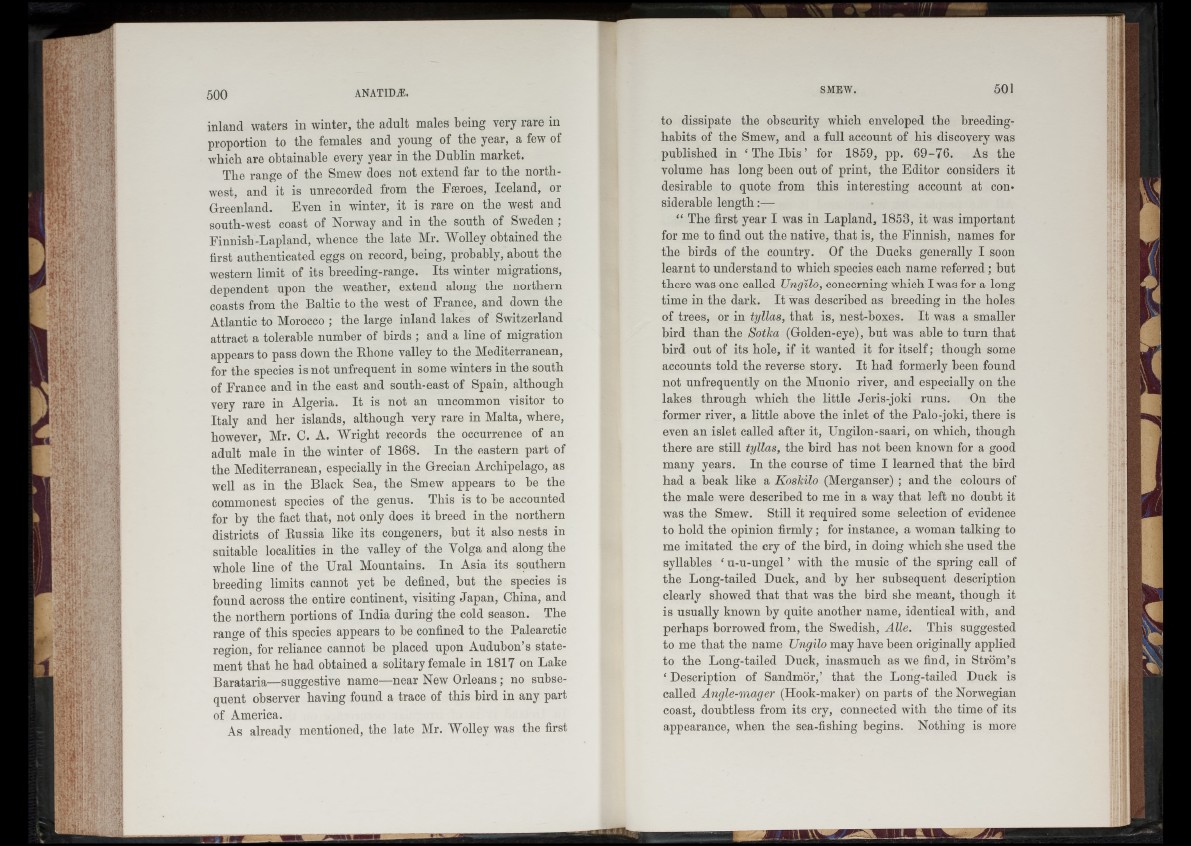
inland waters in winter, the adult males being very rare in
proportion to the females and young of the year, a few of
which are obtainable every year in the Dublin market.
The range of the Smew does not extend far to the northwest,
and it is unrecorded from the Faroes, Iceland, or
Greenland. Even in winter, it is rare on the west and
south-west coast of Norway and in the south of Sweden ;
Finnish-Lapland, whence the late Mr. Wolley obtained the
first authenticated eggs on record, being, probably, about the
western limit of its breeding-range. Its winter migrations,
dependent upon the weather, extend along the northern
coasts from the Baltic to the west of France, and down the
Atlantic to Morocco ; the large inland lakes of Switzerland
attract a tolerable number of birds ; and a line of migration
appears to pass down the Rhone valley to the Mediterranean,
for the species is not unfrequent in some winters in the south
of France and in the east and south-east of Spain, although
very rare in Algeria. It is not an uncommon visitor to
Italy and her islands, although very rare in Malta, where,
however, Mr. C. A. Wright records the occurrence of an
adult male in the winter of 1868. In the eastern part of
the Mediterranean, especially in the Grecian Archipelago, as
well as in the Black Sea, the Smew appears to be the
commonest species of the genus. This is to be accounted
for by the fact that, not only does it breed in the northern
districts of Russia like its congeners, but it also nests in
suitable localities in the valley of the Volga and along the
whole line of the Ural Mountains. In Asia its southern
breeding limits cannot yet be defined, but the species is
found across the entire continent, visiting Japan, China, and
the northern portions of India during the cold season. The
range of this species appears to be confined to the Palearctic
region, for reliance cannot be placed upon Audubon’s statement
that he had obtained a solitary female in 1817 on Lake
Barataria—suggestive name—near New Orleans ; no subsequent
observer having found a trace of this bird in any part
of America.
As already mentioned, the late Mr. Wolley was the first
to dissipate the obscurity which enveloped the breeding-
habits of the Smew, and a full account of his discovery was
published in ‘ The Ibis ’ for 1859, pp. 69-76. As the
volume has long been out of print, the Editor considers it
desirable to quote from this interesting account at considerable
length:—
“ The first year I was in Lapland, 1853, it was important
for me to find out the native, that is, the Finnish, names for
the birds of the country. Of the Ducks generally I soon
learnt to understand to which species each name referred; but
there was one called Ungilo, concerning which I was for a long
time in the dark. It was described as breeding in the holes
of trees, or in tyllas, that is, nest-boxes. It was a smaller
bird than the Sotka (Golden-eye), but was able to turn that
bird out of its hole, if it wanted it for itself; though some
accounts told the reverse story. It had formerly been found
not unfrequently on the Muonio river, and especially on the
lakes through which the little Jeris-joki runs. On the
former river, a little above the inlet of the Palo-joki, there is
even an islet called after it, Ungilon-saari, on which, though
there are still tyllas, the bird has not been known for a good
many years. In the course of time I learned that the bird
had a beak like a Koskilo (Merganser) ; and the colours of
the male were described to me in a way that left no doubt it
was the Smew. Still it required some selection of evidence
to hold the opinion firmly; for instance, a woman talking to
me imitated the cry of the bird, in doing which she used the
syllables ‘ u-u-ungel ’ with the music of the spring call of
the Long-tailed Duck, and by her subsequent description
clearly showed that that was the bird she meant, though it
is usually known by quite another name, identical with, and
perhaps borrowed from, the Swedish, Alle. This suggested
to me that the name Ungilo may have been originally applied
to the Long-tailed Duck, inasmuch as we find, in Strom’s
‘ Description of Sandmor,’ that the Long-tailed Duck is
called Angle-mager (Hook-maker) on parts of the Norwegian
coast, doubtless from its cry, connected with the time of its
appearance, when the sea-fishing begins. Nothing is more